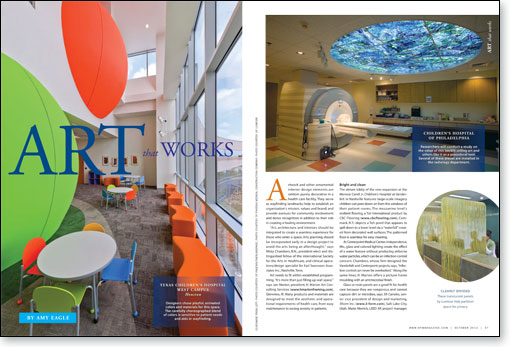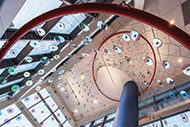
Click the above image for a PDF download
Artwork and other ornamental interior design elements are seldom purely decorative in a health care facility. They serve as wayfinding landmarks; help to establish an organization's mission, values and brand; and provide avenues for community involvement and donor recognition in addition to their role in creating a healing environment.
"Art, architecture and interiors should be integrated to create a seamless experience for those who enter a space. Arts planning should be incorporated early in a design project to avoid the arts being an afterthought," says Misty Chambers, R.N., president-elect and distinguished fellow of the international Society for the Arts in Healthcare, and clinical operations/design specialist for Earl Swensson Associates Inc., Nashville, Tenn.
Art needs to fit within established programming. "It's more than just filling up wall space," says Jan Marion, president, H. Marion Art Consulting Services (www.hmarionframing.com), Glenview, Ill. Many products and materials are designed to meet the aesthetic and operational requirements of health care, from easy maintenance to easing anxiety in patients.
Bright and clean
The atrium lobby of the new expansion at the Monroe Carell Jr. Children's Hospital at Vanderbilt in Nashville features large-scale imagery children can peer down on from the windows of their patient rooms. The mezzanine level's resilient flooring, a Toli International product by CBC Flooring (www.cbcflooring.com), Commack, N.Y., depicts a fish pond that appears to spill down to a lower level via a "waterfall" created from decorated wall surfaces. The patterned floor is seamless for easy cleaning.
At Centerpoint Medical Center, Independence, Mo., glass and colored lighting create the effect of a water feature without producing airborne water particles, which can be an infection control concern. Chambers, whose firm designed the Vanderbilt and Centerpoint projects, says, "Infection control can never be overlooked." Along the same lines, H. Marion offers a picture frame moulding with an antimicrobial finish.
Glass or resin panels are a good fit for health care because they are nonporous and cannot capture dirt or microbes, says Jill Canales, senior vice president of design and marketing, 3form Inc. (www.3-form.com), Salt Lake City, Utah. Maria Merrick, LEED AP, project manager, Lumicor Inc. (www.lumicor.com), Renton, Wash., adds that the panels' translucency allows hospitals to partition spaces for patient privacy in accordance with the federal Health Insurance Portability and Accountability Act without sacrificing daylighting.
John DuBard, AAHID, IIDA, LEED AP, vice president and lead interior designer at the Dallas office of FKP Interiors, says these panels "are basically art pieces." Many design elements, from natural materials to digital images, can be encapsulated in the panels. Hospitals can use these panels to bring elements of the outdoors inside, which they would not otherwise be able to do, Merrick notes.
Vibrant, backlit images mounted on panels by Vertical Visions (www.verticalvisions.biz), Tamarac, Fla., simply can be wiped down with a mild cleaning solution that is compatible with acrylic. The panels can be installed on ceilings or walls or used as room dividers or motion-activated lights. The company's new WOW Walls are only one-inch thick and can be ordered to any size. The products' light-emitting diodes provide "extremely consistent light using very little power," says Glen Turpening, managing member of the company.
New materials and products
Betona flexible concrete tile by PolyCem (http://betona.com), Spring Lake, Mich., is a true oxymoron – tile made of cement mixed with recycled glass and polymers that give the finished product, which is less than a quarter-inch thick, flexibility. The tiles are manufactured in continuous small runs that allow custom orders of 200 square feet or less. "It gives the designer complete flexibility in designing a space," says Jameson Goorman, president, PolyCem.
Users can create designs with a wide range of colors, patterns and sizes, or submit an image to be printed directly onto the tile. "If you had a large enough photograph [taken] with a high enough-resolution camera, we could do a 500-foot-long tile version of that," Goorman says. The tiles are packaged and labeled in such a way that the finished image is easy to piece together during installation.
Remarkable, made by 360° Coatings (www.360coatings.com/), Naples, Fla., is a clear gloss coating that can turn nearly any surface into a white board without disrupting the design of a room. Applying Remarkable "doesn't require any special skill other than knowing how to use a roller," says Susan Anspach, principal, 360° Coatings.
"We all look for things that are cost-effective and serviceable, that someone in the facilities department can repair as needed and someone in the environmental services department can clean," says Louise Nicholson Carter, AAHID, IIDA, EDAC, principal, Skyline Art Services (www.skylineartservices.com), Houston.
Skyline markets patient care boards made of tempered glass for safety, durability and ease of maintenance. The Skyline Switchboard patient care board enables hospitals to switch out a printed insert to provide different artwork and layouts as unit needs change.
Potential procedural tool
Vara Kamin's Impressions of Light Inc. (http://impressionsoflight.com), Minneapolis, offers ceiling- and wall-mounted backlit reproductions of original art by Kamin, a distinguished fellow of the Society for the Arts in Healthcare and former public health nurse. Her nonreferential compositions are highly interpretive, giving them an interactive aspect designed to engage patients' curiosity and interest, regardless of age or culture.
Several of these pieces are installed in the radiology department of the Children's Hospital of Philadelphia, which has begun working with the hospital's institutional review board and research institute to conduct a study into the artwork's use as a procedural tool.
"It's something that over the past five or six years we know works very well," says Chris Tomlinson, the department's administrative director. "Our child life specialists swear by it."
Tomlinson reports caregivers and staff have noticed that patients are less anxious, may require less sedation and need fewer staff resources to complete their treatments when nurses and child life specialists use the images as positive distractions to help ease patients' anxiety. Since the department has 21 sedation bays and eight magnetic resonance imaging machines, this has a huge impact on workflow and patient throughput, he says.
Beautiful and functional
Humans have an innate desire for beautiful, interesting or thought-provoking things to look at, says Sarah Grimes, art consultant at the University of Wisconsin Hospital and Clinics, Madison. In the health care environment, art helps people under stress think of things outside their situations, takes them out of the role of just patient or caregiver and gives them something to talk about with others besides medical issues, she says. With good design, health care interiors can be beautiful and functional.





